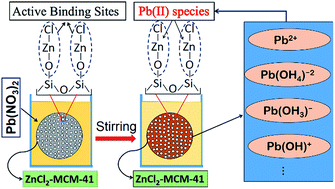Removal of Pb(ii) from aqueous solution by mesoporous silica MCM-41 modified by ZnCl2: kinetics, thermodynamics, and isotherms†
Abstract
A new hybrid nanostructured sorbent ZnCl2-MCM-41, was synthesized by a post-synthesis method in toluene as the solvent. To characterize the sorbent, a number of methods were applied, including X-ray diffraction (XRD), nitrogen adsorption–desorption isotherm, Fourier transform infrared spectroscopy (FT-IR), transmission electron microscopy (TEM), and scanning electron microscopy (SEM). Characterization demonstrated that the sorbent particles are of semi-spherical shape, nanostructured with a 754 m2 g−1 surface area and a 2.86 nm pore diameter. The Pb(II) removal depended on several parameters, including the pH of solution, temperature, initial Pb(II) concentration, sorbent dosage, ionic strength, and the amount of ZnCl2 loaded on the MCM-41 surface. The results showed that the pseudo-second-order model describes the kinetics of sorption better than the pseudo-first-order model. The adsorption continuously increased in the pH range of 2.0–7.0, beyond which the adsorption could not be carried out due to the precipitation of the metal ions. The adsorbent had a considerably high Langmuir monolayer capacity of 479 mg g−1. The adsorption process was exothermic at ambient temperature and the computation of the parameters ΔG°, ΔH°, and ΔS° indicated the interactions to be thermodynamically favorable.


 Please wait while we load your content...
Please wait while we load your content...